Latest News
Kitchen Chat and more…
Kitchen Chat and more…
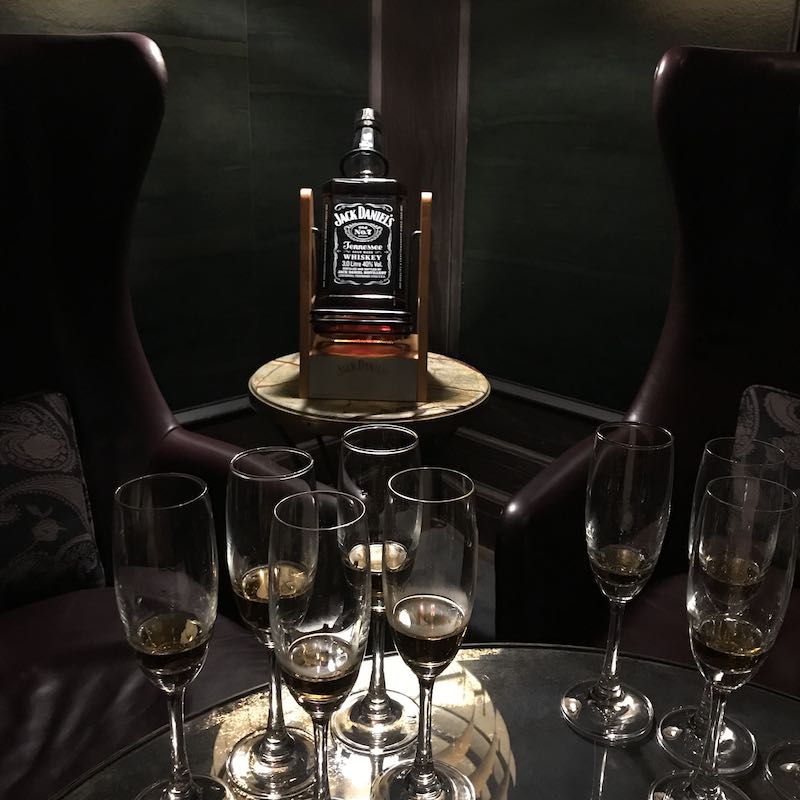
Canon JD No. 7 with tasting glasses
Geek Flora and Choc were invited to a tasting session of Jack Daniels on 6 May 2018 at Manhattan Bar. It was an awesome evening because tasting a famous Tennessee at Asia’s Number One Bar can never go wrong. Besides, the assistant Head Distiller, Mr Chris Fletcher, was in town and we knew that he would answer all our geeky questions.
We reached Manhattan Bar around 7 pm, and the reception ushered us into a private room next to the main bar floor on the right. What we saw was absolute class and luxury as the tall glasses laid in their full glory with the gold nectar within them. The room smelled of whiskey (of course), and we got a little more excited.
In case you do not know, Jack Daniel was indeed a real person. Nobody truly knows Jack’s birthdate, but official records from the distillery stated the 1850s. He was the youngest of 13 children and was very young when his mother died. His father remarried but unfortunately killed shortly after that in the Civil War. Jack did not get along with his stepmother, and hence, he ran away from home at a young age. Jack ended up in Lynchburg, Tennessee where a local lay preacher and moonshine distiller named Dan Call took him in.
Jack began his career as an apprentice distiller with Call and his Master Distiller, Nathan Green. In 1875, Jack received an inheritance from his father’s estate and founded Jack Daniel Distillery with Call. However, Jack took over the distillery shortly afterwards as Call decided to answer his true calling as a preacher.
Jack soon expanded the distillery in 1884 by purchasing the surrounding land. He was getting recognition from the public, and the whiskey gained popularity in the 1880s. The distillery began to bottle their liquid in square bottles in 1897 to convey a sense of fairness and integrity. In 1904, Jack Daniel won a gold medal at the St Louis World’s Fair, and the distillery experienced a surge in demand. However, things looked bad at home with Prohibition oncoming.
Jack gave the distillery to two of his nephews in 1907 due to failing health and died in 1911 due to blood poisoning. One of them became the next owner for 40 years while the other sold his share early. Prohibition laws passed in Tennessee in 1910 and the distillery halted its production in Lynchburg. Two other sites in St Louis, Missouri and Birmingham, Alabama started distilling but failed to produce quality liquid. In 1920, the United States of America passed nationwide prohibition laws, stopping further distillation from taking place.
Despite it all, Lemuel “Lem” Motlow held his uncle’s legacy through the Prohibition and was the front mover in repealing the Tennessee state-prohibition law in 1938. After that, things ran smoothly until 1942, where the U.S government banned production due to World War 2. After the war, Motlow resumed Jack Daniel in 1947. Sadly, he died in the same year and left the distillery to his children.
Jack Daniel distillery began its modern era in 1956 when Brown-Forman bought the distillery from the Motlow family.
Did you know the difference between a bourbon and a Tennessee? To confuse you a little, a Tennessee can be bourbon, but bourbon can never be a Tennessee. Why!?
The definition of bourbon defines it as a liquid made anywhere in the U.S with at least 51% corn and matured in a brand new charred oak cask. The alcohol content of the new make must also be 80% or lower. A Tennessee is a bourbon produced in Tennessee and treated with maple charcoal before maturing in a brand new charred oak cask. The process, called charcoal mellowing, makes all the difference between a Tennessee and a bourbon.
Charcoal mellowing helps to maintain the flavour consistency and soften the whiskey to make it less harsh. Hence, a Tennessee whiskey is always easier to drink than a typical bourbon.
Jack Daniel distillery sources its water from an underground cave spring. The grain percentage is 80% corn, 12% malted barley and 8% rye. The distillery milled the corn and cooked it with hot water to turn it into grist before adding the rye. After that, they allow the mixture to cool before adding the malted barley to the mash. The fermentation team then pumps the mash into the fermentation tanks and add yeast. When fermentation completes, the alcohol abv is around 12%.
Distillation then begins in the 100% copper stills. The 40ft tall column still brings the vapours into a short still with copper plates heated by steam. The system separates the alcohol and then distil it a second time before cooling off into new make. The liquid then passes through 3m of charcoal made on-site for the charcoal mellowing process. The entire process takes about two to three days. After that, it becomes Tennessee whiskey at 70% abv.
As you know, all American whiskey needs maturation in brand-new charred American oak. Jack Daniel is no difference. Their Tennessee whiskey sleeps in brand-new charred American oak casks for at least four years and mostly less than eight years. There is no additional colouring. Maturation in Tennessee is different from Scotland – they need hot summers. Hot summers mean maturation is likely to conclude in five to six years while cooler summers will result in a slightly longer maturation.
Jack Daniel resells all their barrels after using as they are not allowed to use it for the second time. About 25% of all ex-bourbon barrels in the world are Jack Daniel’s!
Jack Daniel also owns two cooperages and have a patent barrel-making process. They buy oak trees, cut them up and build their barrels from scratch. The newly-made barrels are toasted for 17 minutes at 260 degrees Celsius to get the creamy vanilla and caramel into the wood before getting charred for 25 seconds. The cooperages make about 2,000 barrels every day.
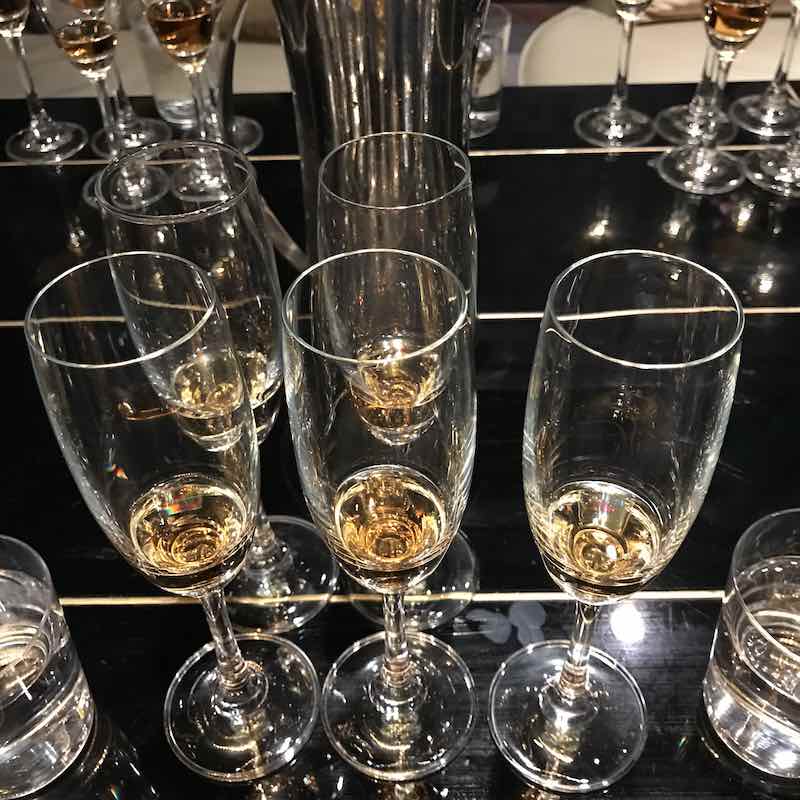
The beautiful glasses for Geek Flora
After reading so much about Jack Daniel, it is time for us to take you on the tasting journey for the night. We had a total of six expressions. They are Gentleman Jack, JD Single Barrel, JD No. 7, JD Gold No. 27, JD American Straight Rye, and JD Sinatra Select. Chris Fletcher, the assistant Head Distiller (pictured below) waxed lyrical about the distillery and its whiskey-making methods, which delighted us (and resulted in the long explanation above)!

Mr Chris Fletcher, Assistant Head Distiller at JD
It is now time to delve into the various JD and see how they are.
As the name suggests, this whiskey is a complete gentleman. Soft-spoken and gentle, the nose is full of melons, pears and bananas with just a hint of oak. The palate is creamy, fruity and soft. Elegant indeed. The finish is too short, but Chris mentioned that the distillery makes it this way as it is an entry whiskey for those who just started learning about whiskey.
A little note about the single barrel: the distillery chooses their single barrels only from the top floor of specific warehouses within the distillery. As they build their warehouses on sites of different heights, the top floor of each warehouse differs from the other. As Jack Daniel depends on the weather for maturation, location of each warehouse plays a big part. The highest floor of each warehouse naturally gets the most heat and hence, considered as one of the best.
The JD Single Barrel is a colossal sugar babe. The nose boasts of molasses, vanilla, melons and Juicy Banana chewing gums. The palate is sweet with molasses, vanilla, melons and spice. It is oily and less creamy than Gentleman Jack. Hints of Juicy Banana chewing gums reappears behind the spice. The finish is medium with oak and ripe banana sweetness. Hints of sweet sandalwood appear with the second sip.
JD No. 7 is well-known in this part of the world, and almost everyone had a JD No. 7 before. The nose is full of molasses, melon and light vanilla. The palate is creamy with vanilla and spice. We get hints of banana sweetness at the end. The finish is too short, with faint banana sweetness and a bit of oak.
The JD Gold No. 27 is an unusual expression. It matures four years in oak before transferring to a maple barrel for six months to a year. The nose boasts of bananas, vanilla and maple syrup. The palate is exceptionally creamy, with molasses, banana, maple and spice at the back of the palate. The finish is medium, creamy and slightly spicy.
The JD rye is a new expression launched in September 2017 that consists of 70% rye, 18% corn and 12% malted barley. The nose is full of banana cream, light spice and sweet sandalwood. The palate brings the sandalwood to the front, with banana cream, earthen spice and light mint at the back of the palate. The finish is short and spicy.
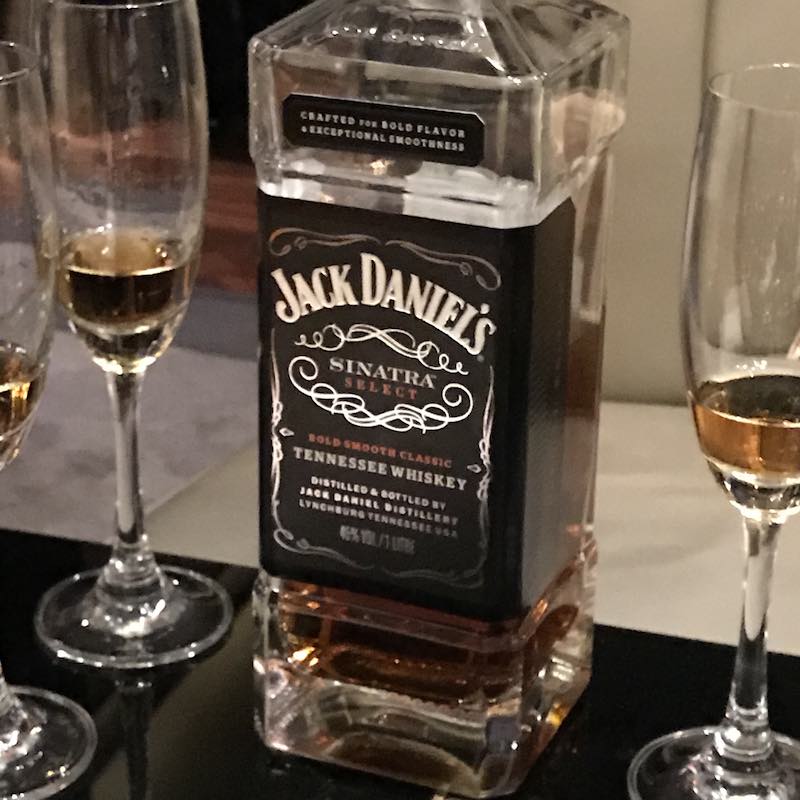
JD Sinatra Select
Finally, the JD Sinatra Select is an expression made to commemorate Sinatra’s 100 Years. He loved Jack Daniels and would promote the brand blatantly even though they never paid him a single cent for advertising. Therefore, this expression celebrates the man who loved his JD.
The nose is oaky, oily with vanilla in the background. The banana scent that is so distinctive JD is weaker too. The palate reveals dry oak, vanilla, bananas and hints of sandalwood. There is some spice also. The finish is medium, with sweet vanilla and oak. It gets slightly dry at the end.
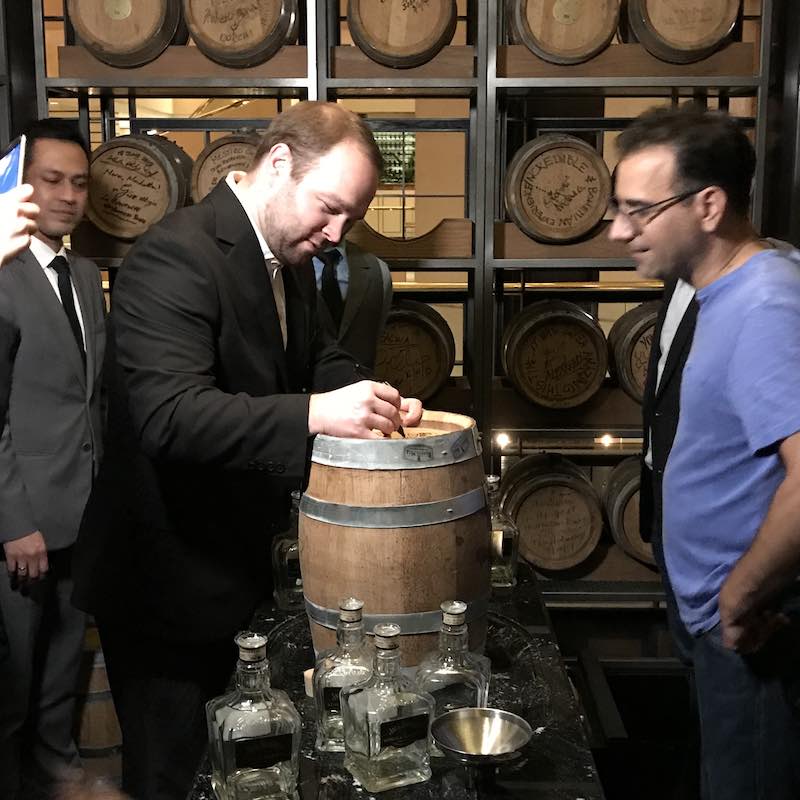
Chris signing the barrel after pouring in the bottles of Gentleman Jack
The tasting session ended with Chris pouring in a few bottles of Gentleman Jack into a barrel at Manhattan Bar to barrel age the whiskey further. As it is part of Manhattan’s barrel-aged program, we may have the chance to try the liquid after the maturation! We shall wait in anticipation.
We certainly enjoyed ourselves that evening and got to know Jack Daniel better as a brand and as a whiskey. We are apparently amazed by the different expressions and have since changed our minds about JD. Just like our friend, Brendan from The Single Cask, said, “So many years of prejudice against Jack Daniels, and it was washed away all in one night.” We feel the same way too!
Peatheads around the world would tell you that peated malts are one of the best things that happened to them. Geek Choc, for one, claims that peated whisky smells heavenly. I am somewhat more reserved on peat, but some of those peated whiskies are fantastic! What is peat? Encyclopedia Britannica defined peat as a spongy material that formed by the partial decomposition of organic matters in wetlands. Depending on the location or terroir, peat can take on different chemical compounds and produce differentiating quality.
As you can see from the above map, Scotland has various locations of peat bogs. Three of them are in Islay, one in Campbeltown, one in Orkney and the remaining two in the Northern Highlands. As we have tasted different characteristics of peaty whiskies, we wonder if the peat from the various locations contributes to the subtle difference in peaty whiskies.
Let’s start with the historical usage of peat in Scotland. Peat was a conventional fuel used in kilning to dry malts in the past. The islands, Campbeltown and the Northern Highlands, used peat regularly as coal was not readily available. Back in the 1940s, it was typical for the Islay and Campbeltown malts to use 100% peat fire, while the Highlands utilised 50-75% peat. The Lowlands used 25-50% peat. By the 20th century, the advances in technology made coal, gas and oil more affordable, and the reliance on peat reduced significantly. Nonetheless, Islay, Campbeltown and Northern Highlands still produce peated whisky today.
Peat formed in waterlogged lands through the partial decomposition of organic matter. It appears that there are differences between peat composition based on the different climate, vegetation, bog type and also the cutting depth during the harvest. We can divide peatlands into bogs, fens, marshes and swamps.
Bogs form through heavy rainfalls and contain more sphagnum moss than the other types of peatlands. Bogs also have lesser woody vegetation as compared to the rest. Fens (better known as basin bogs) have more sedges and grass. Marshes, in general, are treeless waterlogged areas and peat formed very slowly. Swamps, on the other hand, are very minerotrophic and the peat has high wood and nutrients contents.
To delve deeper into the contents of peat from the different peatlands, we need to venture deep into a chemical discussion. To ensure that we do not delve too deep into the scientific names (and lost myself along the way), we will stick to layman terms. In general, peat is 90% water and 10% dry matter. The 10% is sub-divided into 92% organic matter and 8% inorganic. Peat formed from bogs are usually more aromatic due to the higher percentage of phenols and aromatic materials found in them. Peat from fens is less aromatic.
The cutting depth during a peat harvest is as vital as the type of peatland. The surface layers are usually not aromatic enough to create the smokey effects in the whisky that we love, but cutting too deep into the layers can capture too much harmful nitrogen and sulphur compounds in the peat. Therefore, every distillery that makes peated whisky has their own calculated cutting depth to ensure that the peat they use will produce the effects that they want.
Does terroir influence peat? Our research appears to point to the peatland location and cutting depth of the peat as the “influencer”. While the type of peatland and vegetation influence the peat subtly, they are not crucial for the flavours in the whisky. For example, the peat used in Laphroaig and Bowmore are similar to each other as both are fens found on Islay. Yet, the peat found in Laphroaig and Bowmore whiskies are very different. It points to the different cutting depths that both distilleries use, and of course, the interaction between the malts and the casks used. The only difference in the peatlands found in Islay is interestingly from Port Ellen. The contents of the peat using in Port Ellen maltings are woodier in natural and has different microbiology from the rest of Islay.
Interestingly, the peat from Orkney Island is relatively similar to the peat found in the fens of Islay even though it is a bog and not a fen peatland. The peat from the Northern Highlands in Tomintoul is also different from those in Islay, even though it is a fen. The difference in contents across the peatlands in Scotland suggests that peat forms differently due to the climate, microbiology and also the variety of sphagnum moss.
In conclusion, the research points to peat terroir. The contents of the peatland differ across Scotland with local variation found. The cutting depth during the peat harvest also plays a significant role in the flavours of the whiskies as is evident from the different peaty flavours found in whiskies harvesting similar peat.
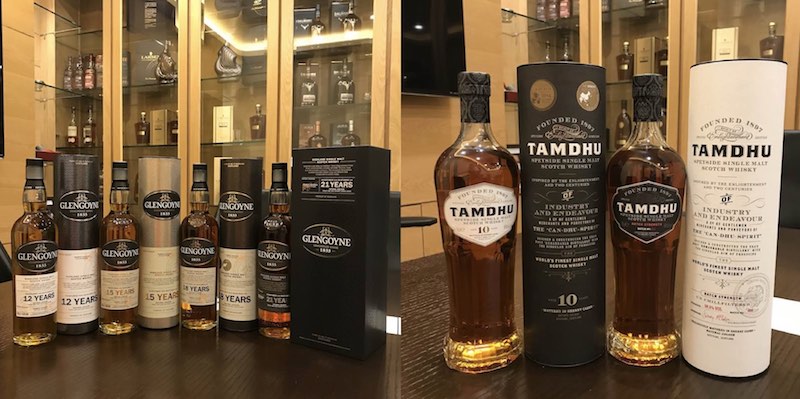
If you are looking forward to the whisky events that we have spoken of in our previous article on Glengoyne Distillery, listen up now! We have received news from the organisers and here are the three finalised events curated just for you!
Jonathan Scott, Business Development Director (Asia), will be here with us for all three events. He hails from Speyside, Scotland and has experiences working with other distilleries such as Jura and Dalmore before joining Ian Macleod Distillers to head both Glengoyne and Tamdhu as their Business Development Director in Asia.
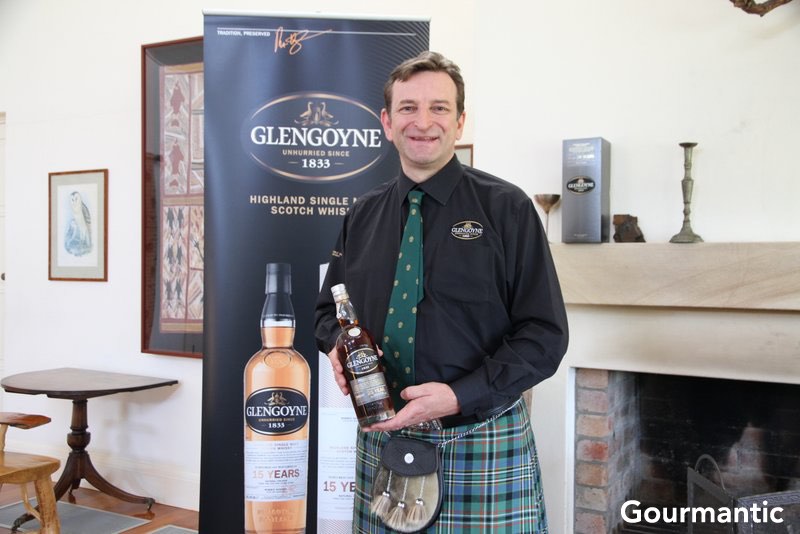
Picture from AsiaEuro
He will be sharing his passion and knowledge for whisky with the participants at all three events. Jonathan will also answer any questions that you have regarding Glengoyne and Tamhdu, so if you have a burning question to ask, you must go to at least one of these events, if not more.
The White Rocket is a cafe located at 5 Stanley Street that provides a fantastic food menu to go with the whisky of your choice. In this Glengoyne Masterclass, Jonathon brings you four different drams from the Glengoyne core range. Going for this Masterclass means you will get to taste the following Glengoyne expressions:
Details of the Masterclass:
Date: Monday, 21 May 2018
Venue: The White Rocket (5 Stanley Street, Singapore 068724)
Time: 7 pm
Cost: $48
Reservations: The White Rocket Facebook Page or call 6221 0108 or email thewhiterocketsg@gmail.com
Join Jonathan Scott as he works hand-in-hand with the Flying Fish Izakaya & Bar to deliver a superb whisky pairing dinner for you at the newly-opened izakaya located at Riverside Point. We are sure that you will salivate just looking at the menu on offer that night.
Details of the Whisky Pairing Session:
Date: Tuesday, 22 May 2018
Venue: The Flying Fish Izakaya & Bar (30 Merchant Road, Riverside Point #01-07, Singapore 058282)
Time: 7 pm
Cost: $128++
Reservations: Email andrewkj.tan@yahoo.com.sg or Call/Whatsapp/SMS 96325338
For those of you who know The Wall SG well, you will know that Jeremie is going to treat you right. Join Jonathan, Jeremie and Samantha as they bring you on a tasting journey through the premium range of Glengoyne expressions. Showing in this Masterclass will be the following:
Feel free to stay on after the event to enjoy more whiskies at this bespoke whisky bar!
Details of the Masterclass:
Date: 23 May 2018
Venue: The Wall SG (76 Tanjong Pagar Road, Singapore 088497)
Time: 7 pm
Cost: $68++
Reservation: The Wall SG Facebook Page or call 6225 7988 (Alternatively, drop Jeremie or Samantha a PM)
Do choose one of the events and head to the venue to enjoy a night of whisky and fun. Learning is always more pleasant when whisky is available! If you want to learn more about Glengoyne Distillery before going for any of the above events, do check out our article on the distillery here. Have fun!
11311 Harry Hines Blvd
Dallas, TX, United States
(555) 389 976
dallas@enfold-restaurant.com
